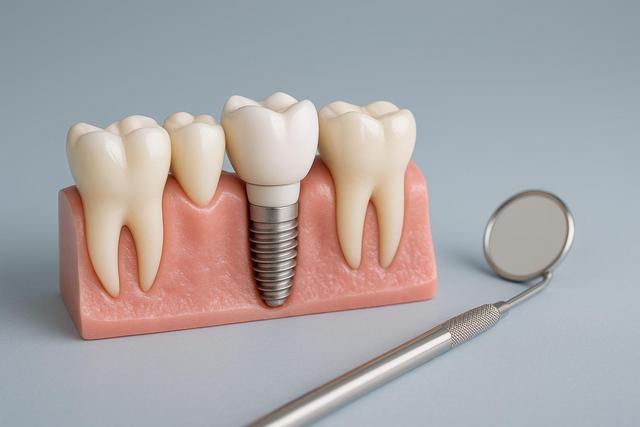
Dental Implants in 2025: Procedure, Costs, Risks, and Everyday Advantages
This article maps out the entire journey of dental implants—from evaluation and planning through surgery, healing, and long-term care—so you know what to expect at each step. It clarifies candidacy criteria, typical timelines, and the most cited risks and complications, placing them in context with long-term success data. You’ll also get a grounded look at the cost of dental implants, with guidance on estimates, insurance, financing, and ways to budget. We highlight the everyday benefits of dental implants and how they compare with bridges and dentures. Finally, you’ll find maintenance checklists, an illustrative patient example, a detailed FAQ, and a curated list of sources to help you speak confidently with your dental team.
Introduction
Tooth loss affects how you chew, speak, and smile—and it can lead to bone loss in the jaw over time. Dental implants are designed to replace a missing tooth’s root and anchor a crown, bridge, or denture securely. For many people, implants offer an appealing balance of function, durability, and aesthetics. This guide explains the essentials in plain language, including the dental implant procedure, candidacy, and long-term care.
Whether you need one tooth replaced or a full-arch solution, understanding your options—and the trade-offs—is key. Let’s walk through what matters most, from recovery timelines to everyday results.
1) How the dental implant procedure unfolds: timeline, steps, and what healing feels like
Most single-tooth cases follow a consistent sequence. After a clinical exam and 3D imaging, your team develops a plan tailored to your bone height, gum health, bite, and cosmetic goals. In straightforward cases, the implant (a titanium or ceramic post) is placed into the jaw where the tooth root once was. Over several weeks to months, the surrounding bone fuses to the implant (osseointegration). An abutment is then secured to the implant, and a custom crown is attached.
As one federal medical resource puts it, dental implants are implanted devices that support crowns, bridges, or dentures and can “significantly improve” quality of life when replacing missing teeth [1]. A leading health system notes typical risks include infection, injury to nearby teeth or nerves, and sinus issues with upper-jaw implants—uncommon but important to review before surgery [2].
Here’s an at-a-glance process many patients experience for a single tooth. Your timeline may be shorter or longer based on bone grafting needs, systemic health, smoking status, and whether the site had an extraction recently.
| Step | What happens | Typical timeframe |
|---|---|---|
| Consult & planning | Exam, 3D imaging, treatment plan, informed consent | 1–2 visits |
| Site preparation | Extraction (if needed) and/or bone graft | Same day procedure |
| Healing after graft | Bone matures to support implant | 6–16 weeks (varies) |
| Implant placement | Implant inserted; temporary may be placed | 1 visit |
| Osseointegration | Bone fuses to implant for stability | 6–12+ weeks |
| Abutment & impressions | Connector placed; crown is designed | 1–2 visits |
| Final crown | Permanent crown attached; bite refined | 1 visit |
Comfort and recovery: Expect mild soreness and swelling for a few days after surgery, usually manageable with routine pain control and a soft-food diet. Many people return to desk work within 1–3 days, though physical jobs may require more downtime. Your team will show you how to clean the area gently during early healing.
Key phrase checklist: You’ve now seen how the dental implant procedure typically moves from planning to a finished crown. In the next section, we’ll explore candidacy, risks, and long-term outcomes.
2) Candidacy, risks, and long-term outlook—what the evidence says
Ideal candidates are generally healthy, don’t smoke (or are willing to stop), and have enough bone volume to stabilize an implant. Certain conditions—uncontrolled diabetes, active periodontal disease, heavy smoking, or recent bisphosphonate/antiresorptive therapy—require a careful risk–benefit discussion. A major medical center emphasizes that risks are usually minor and manageable but can include infection, nerve injury, or sinus problems in the upper jaw [2].
Success and survival: Contemporary systematic reviews of modern implant systems report high 10‑year survival, around 96% at the implant level [3]. That statistic is encouraging, but success also depends on healthy gums and bone over time. Inflammatory complications around implants are not rare: a large meta-analysis estimated peri-implantitis at about 19.5% of patients and 12.5% of implants (definitions vary across studies) [5]. Rigorous home care, regular professional maintenance, and well-fitting restorations all reduce risk.
Implant length and bone grafting trade-offs are an active research area. A 2024 systematic review of 19 randomized trials found that ≤6 mm implants showed similar five‑year survival to ≥10 mm implants in specific scenarios (for example, non-augmented bone and some full‑mouth rehabilitations), potentially reducing the need for sinus lifts in select maxillary cases [4]. Your clinician will tailor recommendations to your anatomy, chewing forces, and hygiene access.
Regulatory and materials context: A federal device authority notes most systems use titanium or zirconia and are evaluated for biocompatibility and safety before marketing [1]. To keep care coordinated across time, the American Dental Association publishes a standard “minimal data set” for implants—effectively a take‑home record of implant type, sizes, and components that can help any future provider service your implant accurately [9].
3) The cost of dental implants: ranges, line items, and smart ways to plan
The cost of dental implants reflects multiple phases: diagnostics (exam, 3D imaging), surgery (implant placement), possible grafting, the abutment, and the final crown or prosthesis. Because each case differs, national ranges are broad. Recent consumer health reporting places a single‑tooth total in the $3,000–$7,000 range (implant, abutment, and crown), with specifics varying by region, provider, and added procedures [6]. A 2025 overview cites $3,100–$5,800 for many single‑tooth cases and notes higher totals for multi‑unit bridges or full‑arch restorations [7]. For localized estimates tailored to your ZIP code, an independent nonprofit tool lets you explore typical dental fees and insurance dynamics [8].
Itemized line items you might see on a treatment plan:
| Component | What it covers | Notes on cost impact |
|---|---|---|
| Exam & 3D imaging | CBCT scan, digital models | Planning accuracy; may be bundled or billed separately |
| Tooth extraction | Simple or surgical | Timing can influence immediate vs. delayed implant |
| Bone graft / membrane | Socket preservation or ridge augmentation | Adds healing time and material/lab costs |
| Implant placement | Surgical insertion of implant body | Specialist vs. GP fees vary; sedation options affect cost |
| Abutment | Connector to crown/bridge | Stock vs. custom CAD/CAM |
| Crown or prosthesis | Single crown, bridge, or full‑arch | Material and lab influence fee (ceramic, zirconia, hybrid) |
| Follow-up & maintenance | Post‑op checks, hygiene visits | Essential for long‑term success |
Insurance and payment strategies: Some dental plans help with portions of surgical or restorative codes, often with annual maximums and waiting periods; estimates vary widely by plan. A practical approach is to request pre‑authorization and sequence care across calendar years when possible to access two annual maximums. Consumer finance and HSA/FSA dollars are commonly used to close gaps; many practices offer third‑party financing with structured monthly payments [7][10].
Bottom line: The cost of dental implants depends on anatomy, complexity, and materials. Getting a written, itemized plan—and asking how changes would affect fees—keeps surprises to a minimum.
4) Everyday outcomes: function, confidence, and the benefits of dental implants (plus alternatives)
People choose implants for stability in chewing, natural‑looking crowns, and the potential to help maintain jawbone where a tooth was lost. A federal device authority lists common benefits—restoring chewing, helping keep adjacent teeth stable, and preserving bone among them [1]. A major health system adds improvements in speech and overall confidence, with the possibility of decades‑long performance when cared for well [12]. These are among the day‑to‑day benefits of dental implants that make them appealing for many adults.
Quality‑of‑life data back up these impressions. A 2023 systematic review found that implant overdentures and full‑arch, implant‑supported prostheses produced large improvements in patient‑reported outcomes (for example, Oral Health Impact Profile scores) in edentulous patients, sustained over follow‑up [11]. If you’re deciding between single implants, bridges, or partial dentures, ask your dentist to walk through dietary goals, hygiene access, and how each option affects nearby teeth.
How do implants compare with other tooth replacements?
| Option | Stability | Effect on adjacent teeth | Longevity (typical) | Maintenance | Notes |
|---|---|---|---|---|---|
| Single implant + crown | Fixed, high chewing force | Does not require drilling neighbor teeth | High 10‑year survival (case‑dependent) | Brush/floss + implant-specific hygiene | Requires surgery and healing |
| 3‑unit bridge | Fixed, good function | Requires preparing abutment teeth | Good 10–15 year range (varies) | Floss threaders/bridging aids | Quicker overall timeline |
| Partial denture | Removable, moderate stability | Clasping on teeth | 5–10 years (varies) | Daily removal/cleaning | Lower upfront cost |
| Implant overdenture (2–4 implants) | Removable but very stable | Spares remaining teeth | Strong long‑term data | Attachment maintenance | Balance of cost, function |
| Full‑arch fixed on implants | Fixed, very stable | Not applicable | Strong long‑term data | Professional maintenance | Higher cost; complex planning |
5) Recovery, maintenance, and a real‑world example
What recovery looks like: After surgery, plan on soft foods, gentle brushing, and avoiding smoking to support healing. Early follow‑ups check the surgical site and bite. A federal resource advises telling providers you have dental implants before MRIs or certain scans and emphasizes regular cleanings for long‑term success [1]. Many teams will schedule hygiene visits two to four times per year initially, especially if you have a history of gum disease.
Personal example: Michael, a 52‑year‑old project manager, chose a single implant after fracturing a lower molar. He worked with a periodontist for placement and his general dentist for the crown. Mild soreness resolved in a few days with over‑the‑counter pain relief; he returned to desk work after 48 hours. Three months later, he received the final crown. His motivation—chewing comfort on the left side without affecting neighboring teeth—was met, and he appreciated how closely the crown matched his natural enamel. Your experience may differ, but this arc is common for healthy non‑smokers with good bone volume.
Staying successful long term:
- Brush twice daily, including around the implant collar; use interdental brushes or floss designed for implants.
- Schedule maintenance visits and professional cleanings as advised; frequency may be higher if you’ve had periodontitis.
- Wear a nightguard if you clench/grind.
- Keep an “implant passport” with part numbers and sizes for future reference [9].
- If you’re choosing a surgeon, you can verify board certification through the American Board of Oral and Maxillofacial Surgery’s patient resource [13].
FAQs
Dental Implants: Frequently Asked Questions
How long do implants last?
With routine care and maintenance, many implants function for decades. Ten‑year survival is reported around the mid‑90% range at the implant level in systematic reviews [3].
Is the surgery painful?
Local anesthesia and, when appropriate, sedation keep you comfortable during placement. Expect mild soreness for a few days after surgery, typically manageable with standard pain control [2].
Am I a candidate if I’ve lost bone?
Often yes. Your team may recommend grafting, or in select cases, short implants that avoid certain grafts while maintaining comparable five‑year survival in specific scenarios [4].
What are the most common complications?
Early issues include temporary swelling and discomfort; later concerns include peri‑implantitis (gum and bone inflammation). Prevalence estimates vary, but patient‑level rates around 20% have been reported across studies with differing definitions [5].
Will insurance cover implants?
Coverage varies widely. Many plans contribute to parts of care but have annual maximums. Use pre‑authorization and planning across calendar years; consider HSA/FSA and third‑party financing if needed [7][10].
Conclusion
Dental implants can restore strong chewing, confident speech, and natural‑looking smiles—while helping preserve bone where teeth are missing. The path from consult to final crown involves careful planning, healing time, and consistent maintenance. Clarify your personal risks and goals, get written, itemized estimates, and keep thorough records of your components. When you weigh the benefits of dental implants against alternatives like bridges or dentures, you’ll be prepared to choose the route that fits your health, budget, and lifestyle.
Websources
- [1] FDA – Dental Implants: What You Should Know
- [2] Mayo Clinic – Dental implant surgery overview
- [3] PubMed – 10‑year implant survival meta‑analysis
- [4] PubMed – Short (≤6 mm) vs long (≥10 mm) implants, 2024 RCT review
- [5] PubMed – Peri‑implantitis prevalence meta‑analysis
- [6] GoodRx Health – Dental implant cost ranges
- [7] Forbes Health – How much dental implants cost (2025)
- [8] FAIR Health – Consumer cost estimator resources
- [9] ADA – Minimal Dental Implant Data Set (ANSI/ADA No. 172)
- [10] CareCredit – Dental implant costs & financing
- [11] PubMed – Patient‑reported outcomes with implant overdentures and fixed prostheses
- [12] Cleveland Clinic – Dental implants: surgery, purpose & benefits
- [13] ABOMS – Patient information and board certification lookup


